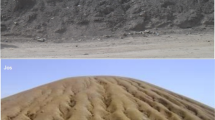Abstract
The paper describes the work of engineering geologists during the planning and construction of underground repositories for radioactive wastes. Various engineering geological methods for the description of rock structure, for the measurement of thermo-mechanical parameters and for the quantitative demonstration of structural stability are discussed in detail.
For a waste disposal mine, the load bearing capacity of the rock, the protective properties of the surrounding rock formations and the geological stability of the area are important factors in a safety analysis of which geotechnical stability analysis is a critical part. Such an analysis comprises an engineering-geological study of the site, laboratory and in situ experiments, model calculations, long term monitoring, and special geological and geochemical investigations. Some general criteria to apply in performing a geotechnical stability analysis have been developed on the b of theoretical consideration and practical experience. They have been used in preliminary repository design calculations for the Gorleben site and for proving the safety of the Konrad site, FRG. Some results of these calculations are given.
According to the multi barrier principle, the geological setting must be able to contribute significantly to the waste isolation over long periods. The assessment of the integrity of the geological barrier can only be performed by making calculations with validated geomechanical models. Natural barriers (consisting of the soil or rock formations surrounding the waste) should ensure that the inflow of water capable of leaching and/or the outflow of contaminated water from the final repository into the biosphere either is fundamentally impossible or at least can be kept within acceptable limits as a result of the natural geohydraulic conditions Therefore, the determination of water conductivity and water permeability along discontinuities is necessary in order to evaluate the barrier efficiency of crystalline host rock.
Various engineering geological data are required for the siting, for the design and construction, and for the safety analysis of a repository. These data can only be attained by the execution of a comprehensive site specific geomechanical exploration and investigation program. Recommendations for such a program are given.
Résumé
Le présent article expose le rôle que joue la géologie de l'ingénieur dans les études pour le choix, la conception et la réalisation de stockages souterrains de déchets radioactifs. Différentes méthodes géotechniques appliquées à la description de la structure des roches, à la mesure des paramètres thermo-mécaniques et à l'appréciation quantitative de la stabilité de la structure sont discutées en détail.
Dans le cas d'une cavité souterraine utilisée pour le stockage de déchets, les propriétés protectrices des formations rocheuses environnantes et la stabilité géologique de la zone sur des facteurs importants pour la sécurité, et parmi ces derniers, l'analyse de la stabilité géotechnique est un point essentiel. Une telle analyse comprend l'étude géologique et géotechnique du site, des essais en laboratoire et in situ, des modélisat de la surveillance à long terme, et des études géologiques et géochimiques particulières. Certains critères généraux qu'il faut prendre en compte lorsqu'on réalise étude géotechnique de stabilité sont développés à partir de diverses données géotechniques sont nécessaires pour le choix du site, la conception, la réalisation, et la mise en sécurité du stockage. Ces données ne peuvent être obtenues qu'en réalisant une étude géomécanique spécifique complète du site. Des recommandations pour sa réalisation sont également données.
Similar content being viewed by others
References—Bibliographie
LANGER M. et al. (1984): Ingenieurgeologie.—In: Angewandte Geowissenschaften, Bd. III (p. 367–520), ed. Bender, F., Enke-V. Stuttgart.
LANGER M. (1982): Some aspects of the activities of engineering geologists during the planning and construction of underground openings.—Panel report, IV. Int. Congr. of Engineering Geology, New Delhi, Vol. IX.
LANGER, M. (1983): La géologie de l'ingénieur peut-elle aider à résoudre le problème du stockage des déchets radio-actifs? —Bull. of IAEG, No. 28, Paris, p. 5–16.
LANGER M. (1983): Safety criteria required for waste disposal. —Proc. Int. Expert Meeting on “Geoenvironment and waste disposal”, UNESCO/IAEA, Vienna, p. 203–205.
LANGER M. & VENZLAFF H. (1984): Sicherheitsnachweis und Störfallanalyse für ein Endlagerbergwerk im Salzgebirge.— Geol. Jb. A 75, Hannover, p. 627–633.
LANGER M. (1980): Grundlagen des Sicherheitsnachweises für ein Endlagerbergwerk im Salzgebirge.—Proc. 4. Nat. Tagung Felsmechanik, Aachen p. 365–408.
BGR (Bundesanstalt für Geowissenschaften und Rohstoffe) (1983): Entwicklung eines optimalen FE-Programmes ANSALT zur Berechnung thermomechanischer Vorgänge bei der Endlagerung hochradioaktiver Abfälle.—Endbericht zum BMFT-Forschungsvorhaben KWA 2070-8 (WALLNER/NIPP).
WALLNER, M. & WULF A. (1982): Thermomechanical calculations concerning the design of a radioactive waste repository in rock salt.—Proc. ISRM Symp. Rock Mechanics: Cavern and pressure shafts, Aachen, Vol. II, p. 1003–1012.
BGR (Bundesanstalt für Geowissenschaften und Rohstoffe) (1984): Gebirgsmechanisches Gutachten zur Stabilität der Abbaue der Schachtanlage ASSE II.—I. Fortschreibung (MEISTER, D. et al.).
DIEKMANN N. et al. (1986): Geotechnical and rockmechanical investigations for the design of the KONRAD repository.— Proc. IAEA Int. Symp. on the siting, design and construction of underground repositories for radioactive wastes, SM 289/47, Hannover.
LANGER M. et al. (1986): Engineering-geological methods for proving the barrier efficiency and stability of the host rock of a radioactive waste repository.—Proc. IAEA Int. Symp. on the siting, design and construction of underground repositories for radioactive wastes, SM 289/23, Hannover.
LANGER M. (1982): Geotechnical investigation methods for rock salt.—Bull. of IAEG, No. 25, Paris, p. 155–164.
WALLNER M. (1986): Stability demonstration concept and preliminary design calculations for the Gorleben repository. —Proc. Conf. Waste Management '86, Tucson (in print).
PAHL A. et al. (1986): Results of Engineering geological research in granite.—Bull. of IAEG, No. 34, Paris.
Author information
Authors and Affiliations
Rights and permissions
About this article
Cite this article
Langer, M. Main activities of engineering geologists in the field of radioactive waste disposal. Bulletin of the International Association of Engineering Geology 34, 25–38 (1986). https://doi.org/10.1007/BF02590232
Issue Date:
DOI: https://doi.org/10.1007/BF02590232




